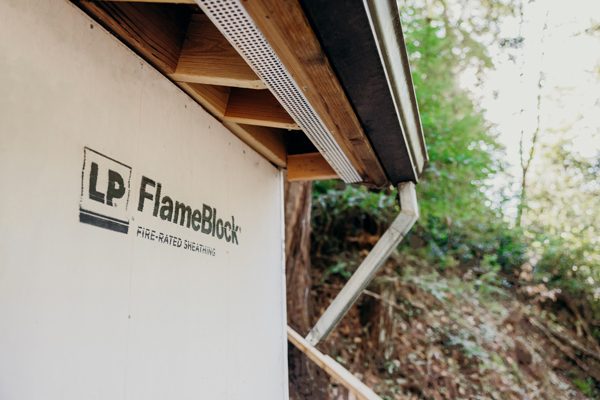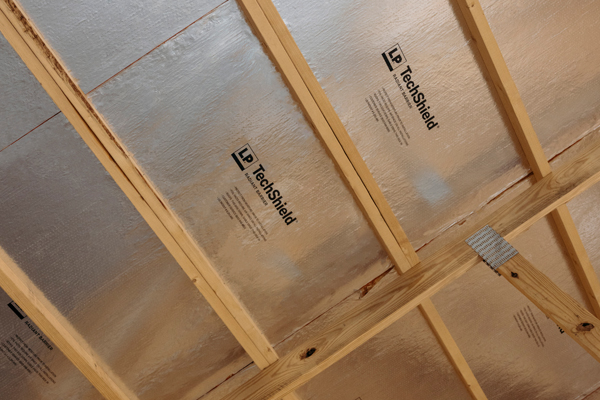Menu
Business Advice8 min
Risk Factor® By First Street Foundation®: A Better Way to Calculate Property Risk
It's not your imagination-the weather is getting worse. In fact, the National Oceanic and Atmospheric Administration (NOAA) reports that billion-dollar weather disasters are increasing, recording 355 events in the 43 years since 1980, 60 of those events occurring in just the past three years. Those numbers don't account for the common severe storms and extreme temperatures that impact our communities, costing thousands of dollars to individual homeowners.
While avoiding extreme weather’s damaging effects is impossible, it is possible to reduce your overall risk with proper assessment and preparation.
To help builders do just that, LP Building Solutions is partnering with the nonprofit climate research and technology company First Street Foundation®. We spoke with Casey Smyth, brand manager for LP Structural Solutions, about the foundation’s valuable tool, Risk Factor®.
How It Works
“We heard about First Street Foundation because LP is focused on climate change and its impact on people’s lives,” says Smyth. “A fundamental part of LP is Building a Better World™ and offering building materials that are more resilient and can potentially give you a better outcome following these natural disasters.”
Risk Factor® is an online assessment tool that makes it easy for builders and homeowners to understand the environmental threats at an address-specific level and to learn how risks can change because the environment is changing.
"This tool is different in that it lets the builder type in the specific address for their new custom home or development and assess the current and future risks those homeowners will likely face from a variety of climate-related perils such as flood, wildfire, extreme heat and hurricane wind," says Smyth. "This allows builders to be more effective and get in front of those specific risks that are pertinent to a particular address." Users can look up individual properties or subscribe for unlimited access to the tool for all of the homes in their portfolio. They can also share these reports directly with homeowners to review any risks together.
How Risk Factor Calculates Risks
The Risk Factor tool calculates the risk for flooding, fire, excessive heat and high wind and assigns the address a score ranging from 1 (minimal) to 10 (extreme) for each threat. This easy-to-understand score helps builders and homeowners not only discover today's risks but also the potential for damage over the next 30 years.
Most databases generalize their output, blanketing flood, heat, storm and wildfire risks across the entire country. Risk Factor creates and calibrates its data at a hyper-local level, which helps communities understand the potential risk at multiple levels from the local and neighborhood to the individual home. Once you know the risks a home may face, you can start to mitigate those risks with Structural Solutions products, which can reduce its vulnerability to those risks.
"The nuanced threat information provided by Risk Factor can be addressed and mitigated with the products in the LP Structural Solutions portfolio. Our products-both individually and in combination-can help you build to meet your unique geographical challenges, whether that is moisture, wildfire or excessive heat," says Smyth.
Scoring Wildfire Potential
The Fire Factor® tool considers surrounding wildland fuels, availability of local fire suppression resources, and likely wildfire ignition locations to determine the probability and intensity of wildfire flames and embers that may reach a property. It also considers the vulnerability of the building’s materials and a measurement of the defensible space surrounding the property to estimate the likely losses that such a property would sustain in a wildfire.
“LP® FlameBlock® Fire-Rated Sheathing combines flame-spread and burn-through resistance to help meet code requirements when ignition-resistant construction is required,” says Smyth. “The panels can bolster a home’s fire-resistance capabilities in wildland-urban interface (WUI) areas.”

Scoring for Extreme Heat
With rising temperatures causing greater heat-related health concerns, more people are retreating to their air-conditioned homes for comfort and safety. The Heat Factor™ tool assesses the property’s distance to water, land elevation and even tree density to determine the severity of extreme heat and how much air conditioning will be needed to stay comfortable.
“If a builder is building a home projected to deal with excessive heat, it may be a good idea to install LP® TechShield® Radiant Barrier, which can block up to 97 % of radiant heat from entering into the attic, helping reduce attic temperatures up to 30 degrees,” says Smyth. “Ultimately the HVAC doesn’t have to work so hard to keep the entire house cool and comfortable, increasing its overall efficiency.”

Protecting Against Damaging Wind
Wind Factor™ calculates the potential for tropical storm-related wind damage, considering the most likely storm tracks, the intensities expected in a changing climate, and the local conditions and characteristics of the property. This includes orientation of the building and maximum wind gust speed likely to be experienced at that specific location. A high wind score means the home will likely be subjected to severe to extreme wind conditions within the next 30 years.
Making the right investments to help protect the home can help reduce costly damage. LP Structural Solutions offers a portfolio of high-performance sheathing products to help protect the structure for greater resiliency. Many of the panels are qualified as Structural I Rated Sheathing, which provides greater cross-panel strength and stiffness for use in particularly demanding portions of a build such as shear walls and floor and roof diaphragms.
Benefits of Risk Factor by First Street with Clients
Risk Factor by First Street Foundation is proving itself to be a valuable tool in that it makes key environmental risk data available to builders and clients, and the damage risks it identifies drill down to the local community level.
“Hopefully, this tool results in better-protected structures and builders will be able to provide more resiliency against climate change threats,” says Smyth. “Providing access to the tool is our way of helping builders and communities understand the risks and helping them make proactive decisions to better protect their homes.”
To explore the Risk Factor tool, visit RiskFactor.com.
Continue Reading
Business Solutions
4 minQ&A: How Home Orientation Impacts Continuous Insulation
There’s a lot to consider when it comes to building an energy-efficient home for your clients and the many nuances that change with each build—including its orientation to the sun.
Continue ReadingResiliency Solutions
5 minHOW A RADIANT BARRIER CAN IMPROVE BURIED DUCT PERFORMANCE
There are several insulation methods based on attic design, but ducts placed over the bottom of truss chords and buried under insulation in a vented attic is a popular builder option.
Sustainability Solutions
8 minHow to Drive Effective Communication and Collaboration on the Jobsite
Every jobsite has a ton of moving parts, from product shipments, supplies, and schedules to subcontractors and homeowners. It's no wonder that many project teams can struggle to maintain quality jobsite communication and collaboration throughout the building process.
Sustainability Solutions
6 minCarbon Negative, Future Positive: LP® Structural Solutions Portfolio Releases Environmental Product Declarations
In an era where environmental responsibility is paramount, we are proud to announce a remarkable achievement: the LP® Structural Solutions portfolio has been officially designated as carbon negative. This milestone is a testament to our unwavering commitment to redefining construction materials for the better with a focus on sustainability, resiliency and groundbreaking advancements.